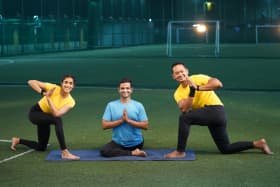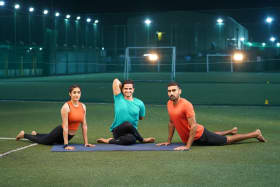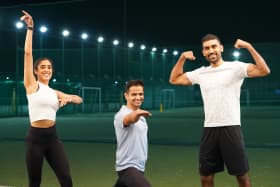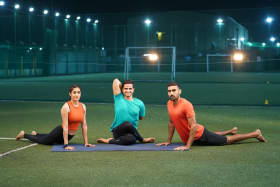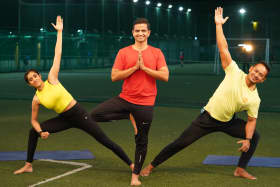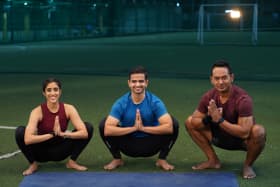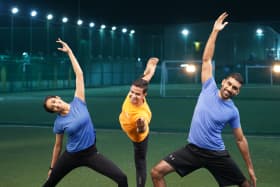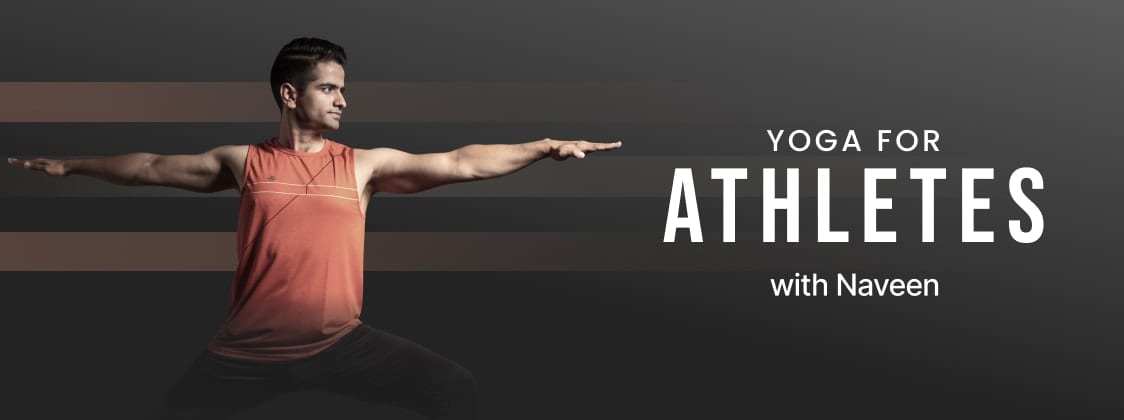
About this pack
If you are someone who walks or takes the stairs or does just about any kind of workout or is engaged in any sport based activity, "You are an Athlete".
What is Yoga?
Yoga is a Hindu practice that is spiritual and an ascetic discipline that involves controlling breath and simple meditation with few bodily postures. The body adapts to all these procedures mentioned above and relaxes accordingly. Yoga is done for all the below stated health problems. They are:
Yoga for Lower Back Pain ,
Yoga Pose for Flexibility ,
Yoga for Neck Pain ,
Yoga for Relaxation ,
Yoga for Weight Loss ,
Yoga for Upper Body ,
Yoga for Lower Body
Why does an Athlete need to practice Yoga?
Yoga for athletes is the key point to bring out the athletic nature in a person. Yoga for athletes has various kinds of postures and poses that improve performance levels. Yoga for young athletes helps them to inculcate more energy and increase the confidence levels of an individual by building the mental resilience that is necessary for competition. These also help control the body, mind, and breath at the same time in a more precise manner which is useful for soccer, field hockey, football, hockey, cricket, and various other sports. By teaching yoga for athletes from the beginning it helps to develop concentration, combating all worldly distractions.
How Athletes can effectively do Yoga at Home every day?
Yoga for young athletes can be done at home regularly with the help of an instructor or without supervision if the person is advanced in fitness. Performing beginner yoga for athletes at home does not require any special equipment and can be done almost anywhere and everywhere as it is effortless as well. Whereas yoga for teenage athletes also helps develop an emotional connection with people around by improving the positive mindset of an individual.
Which Athletes Can Do Yoga?
Yoga for the everyday athlete is ideal for the younger population, and it is reported that all other people with a proper mental and physical health condition can also practice it. People must be encouraged to start doing yoga from an early age. Yoga for athletes can be performed to cope up and practice all the yoga techniques properly. Yoga for athletes at initial sessions might require supervision to avoid health complications and other risks.
Why should some Athletes Avoid Yoga?
Though yoga is ideal for everyone, there are certain exceptional cases to perform and practise yoga for athletes. They are:
Yoga for athletes should be avoided by people with migraine conditions. They should not perform these because it might aggravate the problem.
Yoga for athletes is the best for them, but one must not force it onto people who are not fascinated with it.
The older population should strictly refrain from practising yoga for athletes as there is no research that it is safe for such age groups.
Hernia and bronchitis problems must never take up any yoga for athletes and its breathing lessons.
Other health complications or medical conditions that are serious or requires physician consultation must go ahead after their required medical procedures and processes.
List of Best Yoga for The Everyday Athlete
There are so many postures and poses included in yoga for athletes. The best of them is mentioned below:
Legs up on the Wall Pose
This is the best yoga for athletes pose as it is a kind of restorative pose that replenishes the energy levels in the body by boosting circulation and relaxation. This is done by lying on the back with the legs up against the wall. Then, placing the hips against the wall and the hands along the sides or overhead, the position is held for twenty minutes. It is then done by taking a short break by swinging the leg. It can be done one more time if the body cooperates.
Downward Dog Facing Pose
This pose is done by aligning the body with the correct balance, and it relieves the shoulder and back tightness by alleviating pain and stiffness in muscle groups. This is done by holding the tabletop position by pressing the hands on the floor. The hips are raised towards the ceiling, and then the shoulders are broadened. The spine is elongated, and the head is positioned so that they are in line with the upper arms. The chin is tucked in towards the chest, and then by maintaining a slight bend on the knees, this position is held for at least one whole minute.
Cobra pose
This pose relieves spinal compression by improving flexibility and boosts circulation levels of the blood. This stimulates the throat chakra as it allows the head to turn and gaze upward and then drop back. This pose is done by lying on the stomach with the palms on the ground directly under the shoulders. The elbows are drawn to the body, and then the head is lifted along with the chest. By keeping the elbows bent and broadening the chest, the position is held for forty-five seconds, and then it is repeated thrice.
Bow Pose
This is done by arching the back to the shape of a bow. Then by lying on the belly with the hands-on, the torso with palms facing up. Then by bending the knees, one should exhale and bring the heels as close to the butt. Then by reaching back with the hands and holding the ankles, inhale and firmly lift the heel away from the butt. The thighs should also move away from the floor simultaneously, and the shoulder blades must be firmly against the back with the chest broad. Hold this position for thirty seconds and then release it while exhaling. One should repeat this twice. This is the best pose to stretch and work the thighs, groins, chest, ankles, abdomen, and hip flexors. It also strengthens the back muscles and improves posture.
Dolphin Plank Pose
This pose is a slight modification of the plank, and it strengthens and tones the thighs, arms and core. It is done with the shoulders directly above elbows and placing the torso parallel to the floor. The inner forearms and elbows are set against the floor firmly. Spread the collarbones and firm the shoulder blades. Then by pressing the front thighs towards the ceiling and resisting the tailbone towards the bottom, look down at the floor, taking care of the neck. Hold this position for thirty seconds and then release the knees to the floor and exhale. Repeat this five times with sufficient break in between to help build stamina.
Crescent Pose
This is a variation of high lunge and is done by stepping the right foot forward and exhaling. Then by aligning the knee over the heel, the left leg must be placed solid and firm. Inhale and go upright with the torso. At the same time, doing this, sweep the arms along the sides and then raise them overhead with the palms facing each other. Then by lengthening the tailbone and reaching back on the left heel, one should bring the shoulder blades deep into the back to support the chest. Without pushing the front ribs forward, lift the arms and hold the position for thirty seconds to one whole minute. After release, exhale and sweep the hands back to the floor by stepping the right foot back. Hold your breath and then repeat the entire process with the left foot in front.
One-legged kind Pigeon Pose
This pose is started by sliding the right knee forward to the back of the right wrist. Then the right foot is brought in front of the left knee. Slowly by slinging the left leg back, the knees are straightened and descended to the front of the thighs. Then by having the right knee in an angle outside the hip line, exhale and lay the torso down by stretching the arms forward. Slide the hands back and place the palms firmly on the floor. Roll the left hip towards the right heel and lengthen the groin. By maintaining the pelvis upright without any support, bring the hands to the top of the pelvis by pushing down the rib and dropping the head back. Then lift the chest and push the sternum towards the ceiling. Hold this position for one whole minute and then slide the left knee forward and exhale by lifting. Take some breaths, go back to all fours with another slow and proper exhalation, and repeat it with the legs reversed.
Benefits of Doing Yoga for the Everyday Athlete
The various benefits of yoga for a sports person or the everyday athlete are:
Yoga for soccer players increases the core strength with all its poses and postures.
Yoga for basketball players increases memory power and is therefore essential for people concentrating more on their academics.
Yoga for hockey players increases flexibility and improves the range of motion.
Yoga for cricketers is an effective way to improve body balance in all possible ways.
Yoga for baseball players is the one that is used for cross-training and therefore has various other health benefits that are linked with cross-training too.
The benefits of yoga for sports persons also shows a hike in the body mechanics of all the individuals practising them.
Yoga for football players is seen to build proprioception.
Yoga for cricketers has a tremendous effect by improving body posture, power, strength and speed.
Yoga for sports persons is also seen to provide an optimal alignment to the body by reducing power leakage in the cleans and improving efficiency with all explosive body moves.
Yoga for football players strengthens all the muscles in the body in a very effective way.
Yoga for sports person raises the capacity of the lungs and the patterns of breathing effectively in a positive way. It also tends to overcome asthma and other respiratory conditions with regular practice.
Most importantly, cycling and yoga help a person reduce the risk of injury and also increase the competitive mental frame creating more consistent progress in all the sports.
Yoga and gymnastics are a significant benefit for athletes as it improves recovery. It enhances lymphatic flow that allows the muscles to process all the metabolic by-products at a faster pace. This speeds the healing and also brings about re-growth.
Yoga for footballers improves focus and clarity of the mind.
Yoga and running improve the body's immune function and help balance all the hormonal imbalances. This is therefore very much essential to athletes.
Yoga for footballers helps a person ease their frustration levels effortlessly by reducing stress and detoxifying the body. It allows the muscles to stretch and carry oxygen in the bloodstream.
Disadvantages of Athletes doing Yoga
The significant disadvantages related to yoga for the everyday athlete are:
Yoga poses for cyclists causes stretching of various body parts, thereby leading to injury.
Yoga gymnastics is comparatively expensive than regular yoga practice, and this does not have much regulation of the instructors. This leads to unethical practices in various places.
Yoga gymnastics results are problematic for the fewer population as it does not suit certain body types.
Dos & Don’ts
Yoga for the everyday athlete have a few dos and don’ts, and they are:
One must do all the yoga for sports demonstrated postures well after understanding the stepwise method of it.
One should not bend highly to the front and back while performing yoga for sports to prevent strain to both bones and muscles.
While performing the headstand during yoga for athletes, one should never do it without proper supervision.
Beginners should never exceed twenty minutes during their initial sessions of yoga for cyclists.
One should never hold the asanas for long durations and hold the breath during yoga and sports.
Perform the yoga with all the necessary accessories and essentials to prevent any mishap.
Do not perform yoga for cyclists immediately after the meal and wait for half an hour to consume anything after the yoga sessions.
Things Required to Do Yoga for Athletes if You Are at Home & Gym?
The primary things that are required to perform yoga for the everyday athlete at home or gym are:
Gym mat
Water bottle
Hand towel
Comfortable yoga attire
Yoga block
Exercise ball
Top Searches
Cardio Exercises | Lean Muscle | Lean Body | Weight Loss Exercises | Six Pack Abs | HIIT Workout for Beginners | Exercise for Belly Fat | HRX Workout | Handstand Push Up | Online Fitness Trainer | How To Increase Stamina | Online Yoga Classes | Split Exercise | Workout For Beginners | Dumbbell Exercises | Pilates Workout | Walking Exercise | Pistol Squats | Oblique Exercises | Gym Near Me
Dentist Near Me | Gynaecologist Near Me | Dermatologist Near Me | Endocrinologist Near Me | Pulmonologist Near Me | Cardiologist Near Me | Orthopedist Doctor Near Me | Thyroid Test | Pregnancy Test | Full Body Checkup | Kidney Function Test | Lipid Profile Test | Therapist Near Me | Online Counselling | Physiotherapist Near Me
Sambar | Masala Dosa | Kadai Paneer | Manchow Soup | Chicken Soup | Paneer Masala | Chicken Keema | Badam Milk | Aloo Tikki Chaat | Moong Dal Kachori | Rasmalai | Pav Bhaji | Hummus | Chocolate Ice Cream | Mango Ice Cream | Mango Cake | Paneer | Macaroons | Chicken Biryani | Shawarma
Cult Gyms In India
Gyms In Delhi | Gyms In Mumbai | Gyms In Bangalore | Gyms In Pune | Gyms In Chennai | Gyms In Hyderabad | Gyms In Jaipur | Gyms In Kolkata | Gyms In Ahmedabad | Gyms In Chandigarh | Gyms In Indore | Gyms In Coimbatore | Gyms In Surat | Gyms In Ludhiana | Gyms In Vizag | Gyms In Amritsar | Gyms In Mysore | Gyms In Mangalore | Gyms In Kochi | Gyms In Jammu | Gym In Kharghar | Gym In Bandra | Gym In Velachery | Gym In Chembur | Gym In Indiranagar | Gym In HSR Layout
Types of Gyms by Cult.fit

